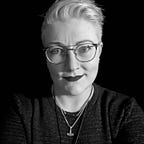New Year’s Resolutions for Designers
As a disability-led self-advocacy organization working to create new paradigms of design through situated knowledge, the questions we most often find ourselves answering are questions asking “how?”
How can we include disabled people’s perspectives?
How do we talk about disabled people without being harmful?
How do we make our events accessible?
How can we benefit from employing or marketing to disabled people?
These aren’t bad questions. People and groups who are asking them have recognized that disabled people are traditionally underrepresented, and systematically excluded from spaces where futures are imagined and decisions are made, and they are trying to address that. But these questions are also limiting.
When we think about disability and ask “how”, we are looking at disability as a problem to be solved. And when we answer questions about “how”, we run the risk of presenting a static solution that erases the complexity, creativity, beauty — and yes, sometimes frustration, struggle and despair — that disability entails.
When we focus on “how to do disability correctly”, we’re missing out on something much more exciting — the fact that disability provides us an opportunity to ask the question, “what could we be doing differently?”
We often think of New Year’s resolutions as to-do lists for the year to come. They’re the steps we’ve identified to move us closer to who and where we already know we want to be. But what if, instead, our resolutions were a chance to ask more questions? To imagine new possibilities for what we can do? To interrogate our world through new perspectives, and allow ourselves to be challenged, delighted, and maybe even a little overwhelmed by what we find?
To that end, here are three resolutions we’re excited to be thinking about in 2019:
Speculating Through Disability
Disability is the experience of living with a non-normative body and/or mind. This means that it is also the experience of living in a world that has largely been designed by and for people who are not like us. It means that we spend a significant portion of our everyday existence engaging with the world and imagining what could be different about it.
In their book Speculative Everything, designers Anthony Dunne and Fiona Raby advocate for conceptual design: “We are more interested in designing for how things could be. Conceptual design provides a space for doing this. It deals, by definition, with unreality” (Dunne and Raby, 2013).
Disability is the experience of constantly navigating reality and unreality simultaneously. Disability is design space created by the tension between that which is real and impossible, and that which is possible and unreal.
Embracing Crip Time
The unreal possibilities of disability are never more apparent than when we venture into the realm of crip time.
Scholar Ellen Samuels writes that, “Crip time is time travel. Disability and illness have the power to extract us from linear, progressive time with its normative life stages and cast us into a wormhole of backward and forward acceleration, jerky stops and starts, tedious intervals and abrupt endings” (Samuels, 2017).
Crip time is joyful and it is grievous.
It is intentionality led by mandatory slowness, iteration across broken timelines, and coordination through overlapping pasts, presents and futures.
It is also unreliable, unpredictable and unmanageable.
It is chaos: a challenging topology in which to engage with complexity.
Becoming Knowledgeably Fearless
The chaotic complexity of disability inspires fear for many people.
Fear is how we are taught to engage with disability: figured as a specter of pain and decay, it haunts discussions of political ideology, environmentalism, and public health. It is the rightful punishment visited upon those who refute social safety nets, engage in thoughtless overconsumption, or fail to take the right steps to maintain their bodies.
And so we learn to be cautious with disability. Before engaging it, we consult with experts, who provide us with a checklist to follow to be sure we are doing things right. And then, somehow, we’re told we’ve done it wrong anyway, and no one appreciates all the effort we went to, and we decide there’s no point in engaging disability at all, because it’s too complicated, and why put yourself out there when there’s no right answer anyway?
But what if, instead of pulling away from the tension and the risk and the vulnerability, we embraced it? What if we looked at the dark humour of chronic illness memes, and found new ways to understand and celebrate strength and resilience? What if we looked at the mutuality and interdependence embodied within care networks, and found new ways to support community-building and knowledge-sharing? What if we looked at the crips laughingly modifying extreme sports equipment to hold their bones together while sitting in bed, and found new ways to understand iterative design processes?
What could we be doing differently?
Work cited:
Dunne, Anthony, and Fiona Raby, 2013. Speculative Everything: Design, Fiction, and Social Dreaming. Massachusetts: MIT Press.
Samuels, Ellen, 2017. “Six Ways of Looking at Crip Time.” Disability Studies Quarterly. Volume 37, №3. DOI: http://dx.doi.org/10.18061/dsq.v37i3
